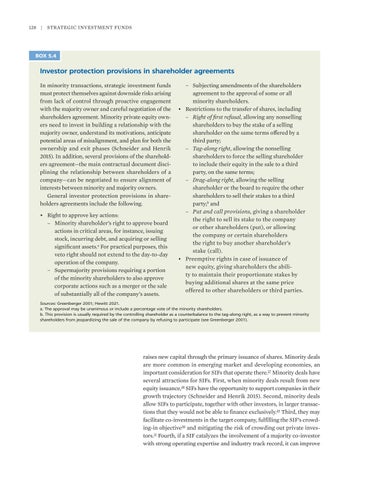128
| Strategic Investment Funds
BOX 5.4
Investor protection provisions in shareholder agreements In minority transactions, strategic investment funds must protect themselves against downside risks arising from lack of control through proactive engagement with the majority owner and careful negotiation of the shareholders agreement. Minority private equity owners need to invest in building a relationship with the majority owner, understand its motivations, anticipate potential areas of misalignment, and plan for both the ownership and exit phases (Schneider and Henrik 2015). In addition, several provisions of the shareholders agreement—the main contractual document disciplining the relationship between shareholders of a company—can be negotiated to ensure alignment of interests between minority and majority owners. General investor protection provisions in shareholders agreements include the following. • Right to approve key actions: –– Minority shareholder’s right to approve board actions in critical areas, for instance, issuing stock, incurring debt, and acquiring or selling significant assets.a For practical purposes, this veto right should not extend to the day-to-day operation of the company. –– Supermajority provisions requiring a portion of the minority shareholders to also approve corporate actions such as a merger or the sale of substantially all of the company’s assets.
–– Subjecting amendments of the shareholders agreement to the approval of some or all minority shareholders. • Restrictions to the transfer of shares, including –– Right of first refusal, allowing any nonselling shareholders to buy the stake of a selling shareholder on the same terms offered by a third party; –– Tag-along right, allowing the nonselling shareholders to force the selling shareholder to include their equity in the sale to a third party, on the same terms; –– Drag-along right, allowing the selling shareholder or the board to require the other shareholders to sell their stakes to a third party;b and –– Put and call provisions, giving a shareholder the right to sell its stake to the company or other shareholders (put), or allowing the company or certain shareholders the right to buy another shareholder’s stake (call). • Preemptive rights in case of issuance of new e quity, giving shareholders the ability to m aintain their proportionate stakes by buying additional shares at the same price offered to other shareholders or third parties.
Sources: Greenberger 2001; Hewitt 2021. a. The approval may be unanimous or include a percentage vote of the minority shareholders. b. This provision is usually required by the controlling shareholder as a counterbalance to the tag-along right, as a way to prevent minority shareholders from jeopardizing the sale of the company by refusing to participate (see Greenberger 2001).
raises new capital through the primary issuance of shares. Minority deals are more common in emerging market and developing economies, an important consideration for SIFs that operate there.27 Minority deals have several attractions for SIFs. First, when minority deals result from new equity issuance,28 SIFs have the opportunity to support companies in their growth trajectory (Schneider and Henrik 2015). Second, minority deals allow SIFs to participate, together with other investors, in larger transactions that they would not be able to finance exclusively.29 Third, they may facilitate co-investments in the target company, fulfilling the SIF’s crowding-in objective30 and mitigating the risk of crowding out private investors.31 Fourth, if a SIF catalyzes the involvement of a majority co-investor with strong operating expertise and industry track record, it can improve
